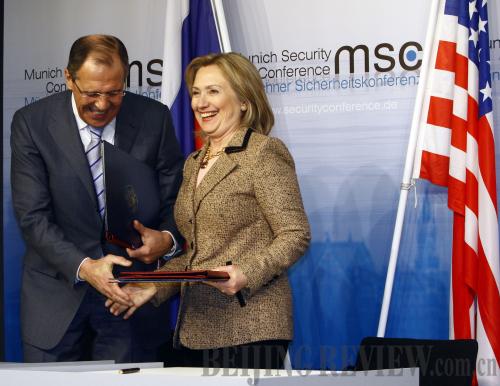|
 |
|
TAKING EFFECT: U.S. Secretary of State Hillary Clinton (right) and Russian Foreign Minister Sergei Lavrov exchange documents on February 5 in Munich, bringing into force the new Strategic Arms Reduction Treaty (XINHUA/AFP) |
The new Strategic Arms Reduction Treaty (new START) officially took effect on February 5 when U.S. Secretary of State Hillary Clinton and Russian Foreign Minister Sergei Lavrov exchanged ratification documents in Munich, Germany.
The United States and Russia signed the treaty on April 8, 2010 to replace START I, which was signed in 1993 and expired on December 5, 2009. According to new START, the two countries should each reduce their deployed nuclear warheads to 1,550 within seven years, a reduction of nearly one third. The new treaty was subsequently ratified by U.S. and Russian lawmakers.
It took a long time to negotiate the new treaty, due to the competing interests of Russia and the United States. As early as 2005, Russia suggested signing a new treaty after START I expired, but the United States showed little interest in this proposal. The United States, however, suggested retaining START I's verification protocol so that it could monitor the implementation of the Strategic Offensive Reductions Agreement (SORT, also known as the Treaty of Moscow) signed in 2002. SORT called on the two countries to limit their deployed nuclear warheads to between 2,200 and 1,700 each. The treaty, originally scheduled to expire by the end of 2012, was superseded by new START.
Moscow insisted the two sides agree on an upper limit and rules for defining strategic missiles; otherwise, verification would make no sense. Subsequently, the two countries tried to negotiate a new nuclear arms reduction treaty, but did not succeed. In addition, their bilateral relationship experienced difficulties when former U.S. President George W. Bush persisted in deploying a missile defense system in Europe.
The inauguration of U.S. President Barack Obama increased the potential for progress in nuclear negotiations. In April 2009, Obama delivered a speech in Prague, the Czech Republic, on building a nuclear-free world. He also declared a new four-phase missile defense program in Europe, which was different from the program pursued by Bush. The move helped ease Russia's concerns. In this more favorable climate, Washington set about to revive negotiations with Russia on a new nuclear arms reduction treaty.
Adjusting policy
The United States was motivated by several factors to change its former unilateral approach to arms control.
For example, the global financial crisis badly hurt the U.S. economy. In addition, the unilateralism of the Bush era damaged the national image of the United States. Furthermore, the country's influence in the world has decreased in recent years.
After the disintegration of the Soviet Union in 1991, the world has moved from a bipolar to multi-polar system, with the appearance of several strong emerging economies. In this context, Washington needed to change its image in order to resume its leadership in arms control. All these factors contributed to Washington's interest in negotiating a new arms reduction treaty with Russia.
Actually, arms reduction is only a game of numbers for the United States. Although new START cuts nearly one third the number of warheads compared to the upper limit set by SORT, this smaller number is only a result of new calculation rules. For example, new START considers a strategic bomber as one warhead. In fact, such a bomber can carry 20 warheads. In addition, reducing the number of warheads is not tantamount to destroying them. So, the United States may store these warheads, leaving the possibility of deploying them again in the future.
The fundamental goal of the United States is to push forward its missile defense program. Although new START mentions a missile defense system, it does not include any terms for regulating such a system. In other words, the United States can continue to develop strategic defense capacity while maintaining a similar number of offensive strategic weapons as Russia. It intends to counteract Russia's nuclear strength through its missile defense system, in order to maintain its nuclear superiority.
Moreover, Washington is being tricky by getting Moscow to accept the United States' missile defense system in Europe. In the future, the United States will likely try to persuade Russia to disregard the missile defense system's capacity to counteract strategic arms and accept an anti-missile system that is continuously upgraded. Then it may surround Russian territory with missile defense systems. In the end, if Russia attempts to launch a strategic nuclear missile, the missile may be shot down over Russia's own territory.
Seeking supremacy
Although the verification mechanism of new START is not as complicated as that of START I, the new treaty requires on-site inspection of Russia's strategic nuclear systems. Without this requirement, it would be hard for the United States to keep on top of Russia's development and deployment of nuclear weapons. Washington holds the belief that it cannot maintain the absolute security of the United States if it is unable to monitor Russian strategic nuclear systems. Before new START was ratified by the U.S. Congress, many U.S. arms control experts pointed out that the United States was losing track of Russia's strategic arms deployment because of START I's expiration, creating a dangerous situation for U.S. national security.
| 